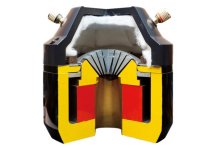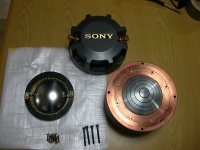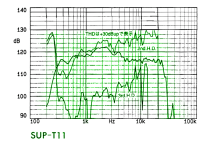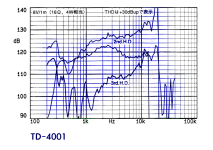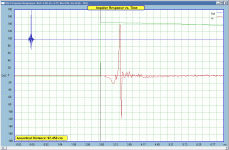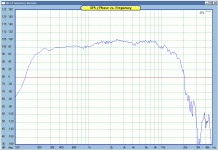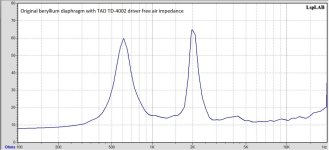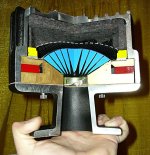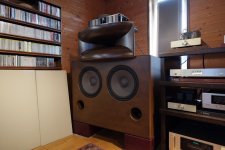Although slightly less relevant compared to woofers, the flux density of the TD-4002 is also higher, potentially leading to lower distortion values (especially IMD).Even if I received TAD TD-4003s for free I would immediately sell them > can't really enjoy beryllium as mentioned before.
But if it has to be beryllium, why not buy a pair of TD-4002s for about $1000-1500 that even includes a removable throat adapter?
View attachment 1171146
View attachment 1171147
I also agree that horn and driver should match and that you cannot separate them to review individually.
Horn + driver make a complete 'horn system', though some like to use comp. drivers naked.
Those modern Sony SUP's from GT sound are surely something, even the originals fared extremely well compared to the TAD 400x series when they were introduced, lower distortion especially on the top end.This one perhaps? 😉
The measurements is from the original Sony SUP drivers.
Not the improved GSU from GT sound. The GSU are 6000$+ each driver if memory serves me right.
4 slit phase plug, 2,0 T, good inductance control with copper shorting ring, copper plated motor, really thin and lightweight alu diaphragm. very interesting large format drivers indeed.
Attachments
Have to agree with you there.But if it has to be beryllium, why not buy a pair of TD-4002s for about $1000-1500 that even includes a removable throat adapter?
They do better without the adapter as a 39mm exit.
Also a better candidate for modern horn designs as they do not exhibit the typical slow flare rate/long throat of it's siblings, when used without the adapter.
Well behaved response, 2,1T neo magnets, 5 slit phase plug,copper shorting ring, well behaved impedance curves and Impulse responses, good distortion measurements.
The only horn i know was specifically designed for it is the TH4371. 70 deg, diffraction horn. from the TCM 1621/22.
And the Cinema horn from the brochure i linked below.
I know @Cask05 have used them with success on his K-402 horns also.
Notice the extremely tight gap, and the rubber that's visible in the cutaway covering most of the depth below the voice coil, to avoid cavity resonances from the space.
This one goes through most of the design details of the 4002, with one completely disassembled, for anyone who is interested. English texting helps for anyone not French ofc.
Attachments
Last edited:
As for another point on modern compression drivers, many of the modern TI diaphragm drivers can benefit very well, from a simple idea that JBL has used for a long time. Being coated diaphragms to damp out the top end resonances, a simple way to improve a CP755ND for example. Even is reversable if not to ones liking.
All one needs is time, patience. Some small brushes, a spinning table and 10$ worth of liquid.
All one needs is time, patience. Some small brushes, a spinning table and 10$ worth of liquid.
Hi Arez,
Kindest regards,
M
can you please provide a link? I found AQUAPLAS only in about 5 gallon quantities.and 10$ worth of liquid
Kindest regards,
M
I visited GT Sound's headquarters on the outskirts of Tokyo a few years back, and listened to three of their speaker systems, all using this compression driver.Those modern Sony SUP's from GT sound are surely something
Superb is the only word that comes close to expressing it.
This is niche ultra-high-end done right (as opposed to the nostalgic jokes from the likes of Goto or ALE, IMHO).
But, when I said (referring to the TADs) that "there is nothing else as good on the market today", I was thinking of mainstream manufacturers, not über-expensive niche ones like GT Sound...
Attachments
Impressive engineering and FEM simulations, no doubt.Axi2050...... 😉
But based on what I've seen, I'm still not convinced that these would be an actual improvement on the TADs.
I still think they can be classified in the "almost (but not quite) as good, while certainly cheaper to manufacture at scale" category.
It depends on the intended use, better in what context is a better question.I still think they can be classified in the "almost (but not quite) as good, while certainly cheaper to manufacture at scale" category.
At what degree are you basing this? Eyeballing?
If you want a LARGE miodrange horn and Xo at 3-400 hz (Axi 2050 distortion starts rising below 350hz, 300hz probably okay for home use), then the AXI2050 does that better then any other single diaphragm driver. It has been designed for that purpose, to go low in PA applications and be abused, 150/300w power rating. It will give you half to one octave lower extension compared to normal 4" diaphragm drivers.
But it has a higher xmax, heavier and large diaphragm (175mm ish) comparatively, larger wire used, larger clearances for more air evacuation and so on, designed to be robust, and it is considerably cheaper to manufacture. And it does not defy the laws of physics, no matter how good the engineering is. The engineering choices made points towards a large format midrange compression driver, to avoid xos in the midrange band. A driver covering 300 hz will also naturally exhibit more excursion and therbey, higher IMD and distortion in the top end.
It's natural competitors are BMS coaxials and the new B&C DCX drivers etc.
A driver like the TAD 4001/2/3 etc, has a diaphragm that weighs less then 1 gram, GT sound GSU uses a 35μm thick alu (dont have the weight), JBLs 476 be 2,1 grams mms, etc.
Smaller compression drivers with lighter diaphragms like that, will have higher sensitivity, better distortion, and more output above 10khz, used within they're comfort zone. Which is natural for a compression driver that was designed to cover 700-20k, with emphasis on the upper band more then low end extension.
But they will distort driven to 300 hz and are not generally suited for that use, also they do not handle that kind of power and abuse as a AXI 2050.
They are easier to use and eq as the top end does not drop off as much, making them more suitable for use with passive xos, which all things considered still is the majority of the market for home use etc.
The AXI can be padded down over it's midband to make it "flat" but that is 20db+, or the top end can be eqd up with active eq but you are 'amplifying' the worst part of the driver with +20db.
The more classic two way designs, requires smaller horns/waveguides to make use of they're output, and match directivity at XO.
What is better depends on you'r desired design and the rest of the system.
Comparing 2 compression drivers is also difficult.
Different exits, throats, diameters, lengths, phase plugs, diaphragm shapes etc, means in general there are very very few compression drivers that fits the same horn, hence a direct comparsion with a eqd response is a flawed test in general.
Most of us don't have PWTs available to test drivers in, so that is how it is.
So which is better? make your own decision on your design criterias, because this discussion will never end up at a single driver or a few.
Last edited:
Well, Jack Oclee-Brown said in link below, this driver was developed for cinema or home use. (Don't know if it's in part 1 or 2) Each to their own to have opinions behind the keyboard, dismissing all new drivers categorically. With that said, I've never heard a TAD, SUP or GT driver. But I would never say that they are not good based on being old designs! What I do know, my ears (or mind😱) is not to trust when it comes to sighted listening...
Lastly another clue to the puzzle, using a typical modern PRO woofer look at the link below, top of the line modern drivers.
A older outdated TAD 1603 (same cone/coil etc as the current 1601B), you can see it remains very clean, without breakup much higher up. It's natural response extends lower and makes the distortion almost comparable, IMD is better as expected etc.
Using that driver to 700hz with moderate xo slopes will sound better as it does not go into breakup as early as the BMS or 18s.
But it requires a largrer enclosure, and does not take power as well as the more modern designs that will benefit more from lower XOs to a compression driver. The BMS is likely the winner if you want a small enclosure, XO at 300hz and force the response on the bottom up. Again different design choices and priorities makes the best fit for the corresponding horn and CD.
https://www.justdiyit.com/comparatif-15-pouces-pro/
https://www.justdiyit.com/comparatif-15-pouces-pro/3/
A older outdated TAD 1603 (same cone/coil etc as the current 1601B), you can see it remains very clean, without breakup much higher up. It's natural response extends lower and makes the distortion almost comparable, IMD is better as expected etc.
Using that driver to 700hz with moderate xo slopes will sound better as it does not go into breakup as early as the BMS or 18s.
But it requires a largrer enclosure, and does not take power as well as the more modern designs that will benefit more from lower XOs to a compression driver. The BMS is likely the winner if you want a small enclosure, XO at 300hz and force the response on the bottom up. Again different design choices and priorities makes the best fit for the corresponding horn and CD.
https://www.justdiyit.com/comparatif-15-pouces-pro/
https://www.justdiyit.com/comparatif-15-pouces-pro/3/
These 2 modern 15" woofers are pure subwoofers - built to have a crossover in the 100Hz area. You need to look for a design which is built for extended range.
Many PA drivers don't have good linearity at low levels - but there are some. PHL is not used for no reason by most studio monitor companies in their big speakers. Audax also had/has a great 15".
Many PA drivers don't have good linearity at low levels - but there are some. PHL is not used for no reason by most studio monitor companies in their big speakers. Audax also had/has a great 15".
to Resume BMS coaxial or Celestion AXI 2050 to replace a mid range driver at 300hz or Tad 4000 , Beyma 755, or any 3inch compression driver if you need to crossover at 700hz . the question is what is the best to have the same driver doing 300hz to 6K and add a tweeter or having a 15inch driver going to 600/700hz and the compression driver doing 700/ 20K ? i have a JBL 2216ND and even if in the M2 or the JBL4367 they let it run to 700hz , my actual 6.5 Full range driver do a better Job between 250hz and 800.hz than the 15inch JBL

Last edited:
There is one more option: https://www.limmerhorns.de/042/
The benefit would be a 1" driver perfectly working up to 20kHz.
I also really like my BMS compression driver (but I use it for PA) but it's hard to find a big 2" horn which also works very well >10kHz. But adding a tweeter defeats the whole single-point-coax design ...
The benefit would be a 1" driver perfectly working up to 20kHz.
I also really like my BMS compression driver (but I use it for PA) but it's hard to find a big 2" horn which also works very well >10kHz. But adding a tweeter defeats the whole single-point-coax design ...
For domestic use I would prefer this one
https://www.limmerhorns.de/630-bc1/
That said,I had a lot of exposure to RCF ART 745 with ND950 driver. Looking at the impedance, 10kHz looks like a mess, couldn’t care less😉 Mids are fantastic, crossed somewhere 600-700Hz.
https://www.limmerhorns.de/630-bc1/
That said,I had a lot of exposure to RCF ART 745 with ND950 driver. Looking at the impedance, 10kHz looks like a mess, couldn’t care less😉 Mids are fantastic, crossed somewhere 600-700Hz.
With bi-amping the coaxial driver, you can work around this problem. A large horn (say from 400Hz up) will probably not load the driver above 6kHz, but then the tweeter takes over. That is the way I made it work in my horn, someone else's mileage may vary of course.I also really like my BMS compression driver (but I use it for PA) but it's hard to find a big 2" horn which also works very well >10kHz
- Home
- Loudspeakers
- Multi-Way
- Best Compression Drivers today 2022?
